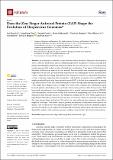Files in this item
Does the zinc finger antiviral protein (ZAP) shape the evolution of herpesvirus genomes?
Item metadata
| dc.contributor.author | Lin, Yao-Tang | |
| dc.contributor.author | Chau, Long-Fung | |
| dc.contributor.author | Coutts, Hannah | |
| dc.contributor.author | Mahmoudi, Matin | |
| dc.contributor.author | Drampa, Vayalena | |
| dc.contributor.author | Lee, Chen-Hsuin | |
| dc.contributor.author | Brown, Alex | |
| dc.contributor.author | Hughes, David J. | |
| dc.contributor.author | Grey, Finn | |
| dc.date.accessioned | 2021-09-29T11:30:05Z | |
| dc.date.available | 2021-09-29T11:30:05Z | |
| dc.date.issued | 2021-09-17 | |
| dc.identifier | 276081779 | |
| dc.identifier | 55962ac0-d662-4441-b828-8b5c018203be | |
| dc.identifier | 85115646472 | |
| dc.identifier | 000700124400001 | |
| dc.identifier.citation | Lin , Y-T , Chau , L-F , Coutts , H , Mahmoudi , M , Drampa , V , Lee , C-H , Brown , A , Hughes , D J & Grey , F 2021 , ' Does the zinc finger antiviral protein (ZAP) shape the evolution of herpesvirus genomes? ' , Viruses , vol. 13 , no. 9 , e1857 . https://doi.org/10.3390/v13091857 | en |
| dc.identifier.issn | 1999-4915 | |
| dc.identifier.other | Jisc: f7106698d99249a0ac986811afff2bfd | |
| dc.identifier.uri | https://hdl.handle.net/10023/24044 | |
| dc.description | Funding: This research was funded by Academy of Medical Sciences https://acmedsci.ac.uk (accessed on 14 September 2021) (SFB003/1028) (D.J.H.), Tenovus Scotland https://tenovus-scotland.org.uk (accessed on 14 September 2021) (T20/63 and T18/05) (D.J.H.), The Wellcome Trust Institutional Strategic Support Fund https://wellcome.org (accessed on 14 September 2021) (ISSF) (D.J.H.) the Medical Research Council https://mrc.ukri.org (accessed on 14 September 2021), MR/N001796/1 (FG) and the Biotechnology and Biological Sciences Research Council https://bbsrc.ukri.org (accessed on 14 September 2021), BBS/E/D/20002172 (FG). | en |
| dc.description.abstract | An evolutionary arms race occurs between viruses and hosts. Hosts have developed an array of antiviral mechanisms aimed at inhibiting replication and spread of viruses, reducing their fitness, and ultimately minimising pathogenic effects. In turn, viruses have evolved sophisticated counter-measures that mediate evasion of host defence mechanisms. A key aspect of host defences is the ability to differentiate between self and non-self. Previous studies have demonstrated significant suppression of CpG and UpA dinucleotide frequencies in the coding regions of RNA and small DNA viruses. Artificially increasing these dinucleotide frequencies results in a substantial attenuation of virus replication, suggesting dinucleotide bias could facilitate recognition of non-self RNA. The interferon-inducible gene, zinc finger antiviral protein (ZAP) is the host factor responsible for sensing CpG dinucleotides in viral RNA and restricting RNA viruses through direct binding and degradation of the target RNA. Herpesviruses are large DNA viruses that comprise three subfamilies, alpha, beta and gamma, which display divergent CpG dinucleotide patterns within their genomes. ZAP has recently been shown to act as a host restriction factor against human cytomegalovirus (HCMV), a beta-herpesvirus, which in turn evades ZAP detection by suppressing CpG levels in the major immediate-early transcript IE1, one of the first genes expressed by the virus. While suppression of CpG dinucleotides allows evasion of ZAP targeting, synonymous changes in nucleotide composition that cause genome biases, such as low GC content, can cause inefficient gene expression, especially in unspliced transcripts. To maintain compact genomes, the majority of herpesvirus transcripts are unspliced. Here we discuss how the conflicting pressures of ZAP evasion, the need to maintain compact genomes through the use of unspliced transcripts and maintaining efficient gene expression may have shaped the evolution of herpesvirus genomes, leading to characteristic CpG dinucleotide patterns. | |
| dc.format.extent | 15 | |
| dc.format.extent | 1311700 | |
| dc.language.iso | eng | |
| dc.relation.ispartof | Viruses | en |
| dc.subject | Herpesvirus | en |
| dc.subject | Zinc finger antiviral protein | en |
| dc.subject | Dinucleotide | en |
| dc.subject | CpG | en |
| dc.subject | QH301 Biology | en |
| dc.subject | QH426 Genetics | en |
| dc.subject.lcc | QH301 | en |
| dc.subject.lcc | QH426 | en |
| dc.title | Does the zinc finger antiviral protein (ZAP) shape the evolution of herpesvirus genomes? | en |
| dc.type | Journal item | en |
| dc.contributor.sponsor | Tenovus-Scotland | en |
| dc.contributor.sponsor | Academy of Medical Sciences | en |
| dc.contributor.sponsor | Tenovus-Scotland | en |
| dc.contributor.institution | University of St Andrews. Biomedical Sciences Research Complex | en |
| dc.contributor.institution | University of St Andrews. School of Biology | en |
| dc.identifier.doi | 10.3390/v13091857 | |
| dc.description.status | Peer reviewed | en |
| dc.identifier.grantnumber | en | |
| dc.identifier.grantnumber | SBF003/1028 | en |
| dc.identifier.grantnumber | en |
This item appears in the following Collection(s)
Items in the St Andrews Research Repository are protected by copyright, with all rights reserved, unless otherwise indicated.

